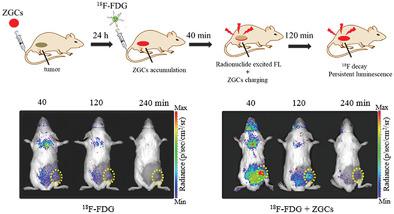Our official English website, www.x-mol.net, welcomes your feedback! (Note: you will need to create a separate account there.)
In Vivo Repeatedly Activated Persistent Luminescence Nanoparticles by Radiopharmaceuticals for Long-Lasting Tumor Optical Imaging.
Small ( IF 13.3 ) Pub Date : 2020-06-08 , DOI: 10.1002/smll.202001494 Nian Liu 1, 2 , Junpeng Shi 3 , Qiang Wang 4 , Jingru Guo 1 , Zhenyu Hou 4 , Xinhui Su 4 , Hongwu Zhang 3, 5 , Xiaolian Sun 1, 4
Small ( IF 13.3 ) Pub Date : 2020-06-08 , DOI: 10.1002/smll.202001494 Nian Liu 1, 2 , Junpeng Shi 3 , Qiang Wang 4 , Jingru Guo 1 , Zhenyu Hou 4 , Xinhui Su 4 , Hongwu Zhang 3, 5 , Xiaolian Sun 1, 4
Affiliation

|
Persistent luminescence nanoparticles (PLNPs) with rechargeable near‐infrared afterglow properties attract much attention for tumor diagnosis in living animals since they can avoid tissue autofluorescence and greatly improve the signal‐to‐background ratio. Using UV, visible light, or X‐ray as excitation sources to power up persistent luminescence (PL) faces the challenges such as limited tissue penetration, inefficient charging capability, or tissue damage caused by irradiation. Here, it is proved that radiopharmaceuticals can efficiently excite ZnGa2O4:Cr3+ nanoparticles (ZGCs) for both fluorescence and afterglow luminescence via Cerenkov resonance energy transfer as well as ionizing radiation. 18F‐FDG, a clinically approved tumor‐imaging radiopharmaceutical with a short decay half‐life around 110 min, is successfully used as the internal light source to in vivo excite intravenously injected ZGCs for tumor luminescence imaging over 3 h. The luminescence with similar decay time can be re‐obtained for multiple times upon injection of 18F‐FDG at any time needed with no health concern. It is believed this strategy can not only provide tumor luminescence imaging with high sensitivity, high contrast, and long decay time at desired time, but also guarantee the patients much less radiation exposure, greatly benefiting image‐guided surgery in the future.
中文翻译:

放射性药物在体内的反复重复激活持久发光纳米粒子,用于持久肿瘤光学成像。
具有可充电近红外余辉特性的持久发光纳米粒子(PLNP)可以避免活体动物自发荧光并大大提高信噪比,因此在活体动物的肿瘤诊断中引起了人们的广泛关注。使用紫外线,可见光或X射线作为激发源来增强持久发光(PL)的能力面临着挑战,例如组织穿透力有限,充电效率低下或辐照导致组织损伤。在此,证明了放射性药物可以通过切伦科夫共振能量转移以及电离辐射有效激发ZnGa 2 O 4:Cr 3+纳米颗粒(ZGC)的荧光和余辉发光。18F-FDG是一种临床认可的肿瘤成像放射性药物,具有约110分钟的短衰变半衰期,已成功地用作内部光源,在体内激发静脉注射的ZGC进行3小时的肿瘤发光成像。在不考虑健康的情况下,在任何时候注入18 F-FDG都可以多次获得具有类似衰减时间的发光。相信这种策略不仅可以在期望的时间提供具有高灵敏度,高对比度和长衰减时间的肿瘤发光成像,而且可以保证患者更少的放射线照射,极大地有益于将来的图像引导手术。
更新日期:2020-07-02
中文翻译:

放射性药物在体内的反复重复激活持久发光纳米粒子,用于持久肿瘤光学成像。
具有可充电近红外余辉特性的持久发光纳米粒子(PLNP)可以避免活体动物自发荧光并大大提高信噪比,因此在活体动物的肿瘤诊断中引起了人们的广泛关注。使用紫外线,可见光或X射线作为激发源来增强持久发光(PL)的能力面临着挑战,例如组织穿透力有限,充电效率低下或辐照导致组织损伤。在此,证明了放射性药物可以通过切伦科夫共振能量转移以及电离辐射有效激发ZnGa 2 O 4:Cr 3+纳米颗粒(ZGC)的荧光和余辉发光。18F-FDG是一种临床认可的肿瘤成像放射性药物,具有约110分钟的短衰变半衰期,已成功地用作内部光源,在体内激发静脉注射的ZGC进行3小时的肿瘤发光成像。在不考虑健康的情况下,在任何时候注入18 F-FDG都可以多次获得具有类似衰减时间的发光。相信这种策略不仅可以在期望的时间提供具有高灵敏度,高对比度和长衰减时间的肿瘤发光成像,而且可以保证患者更少的放射线照射,极大地有益于将来的图像引导手术。


























 京公网安备 11010802027423号
京公网安备 11010802027423号